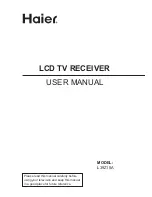
©
2002 RadioShack Corporation.
All Rights Reserved.
RadioShack and RadioShack.com are trademarks
used by RadioShack Corporation.
19-1108
OWNER’S MANUAL — Please read before using this equipment.
Thank you for purchasing a RadioShack HTX-420 2-Meter/70 cm Dual Band FM Amateur
Transceiver. Your transceiver is compact and rugged, making it easy to carry almost anywhere.
The crystal controlled circuitry provides accurate and stable frequency selection, making it an
ideal choice for your amateur communications needs.
+0641&7%6+10
"
61
"
#/#6'74
"
4#&+1
Amateur radio is a great hobby that has
enriched the lives of millions of people all
over the world. Your transceiver is the perfect
first radio for anyone entering the exciting
world of amateur radio, or as a great
additional transceiver for the experienced
amateur radio operator. Your transceiver
opens a door for you to the world from almost
anywhere! All you need is an Amateur Radio
Operator's License (Technician Class or
higher) issued by the Federal
Communications Commission (FCC). If you
do not have a license, it is easy to get one,
and help from licensed operators is available.
Find out if there is a ham radio club in your
area. Most clubs welcome newcomers and
are glad to help you get your license. Here
are a few tips to help you get started.
You can turn on your transceiver and scan
the entire band to hear what is going on;
however, do not attempt to transmit until
you get your license. If you transmit without
a license, you are in violation of federal law
that can lead to severe penalties. Ham
operators take the FCC rules very seriously
and want nothing to do with “bootleggers” –
their term for people who operate without a
license.
±
±
±
±
If you do not hear anyone talking about a
local club as you listen to local transmissions,
write to the American Radio Relay League
(ARRL) at the following address to find out
how to contact a local affiliate. The ARRL is
the national organization representing
amateur radio in the United States. The
league has more than 150,000 members.
Most are ham operators, or members in the
process of obtaining their license.
The American Radio Relay League
225 Main Street
Newington, CT 06111
http://www.arrl.org
Start studying for the license exams. Most
people can go from knowing absolutely
nothing about amateur radio to passing the
Technician written exam in less than a
month.
The exams test your knowledge of basic
radio regulations and elementary radio
theory. Many clubs hold license classes
which can be a fun and easy way to learn
%106'065
Preparation .................................................................. 2
Using Internal Batteries ........................................... 2
Using AC or DC Power ............................................ 2
Connecting the Antenna .......................................... 2
Attaching the Belt Clip ............................................. 2
Attaching the Wrist Strap ......................................... 2
Connecting a Microphone/Speaker ......................... 2
A Quick Look At the Display ........................................ 3
Operation ..................................................................... 4
Manual Conventions ................................................ 4
Turning On/Off the Transceiver ................................ 4
Setting the Squelch Level ........................................ 4
Temporarily Opening Squelch .................................. 4
Using the Universal Type Keys ................................ 4
Selecting Frequencies (Direct Tuning) and Receiving
Transmissions .......................................................... 4
Transmitting ............................................................. 4
Understanding Repeaters ............................................ 5
Setting the Repeater Offset Frequency ................... 5
Turning Repeater Operation On/Off and Changing
The Offset Direction ................................................. 5
Memory Operation ....................................................... 5
Storing a Transmit/Receive Frequency .................... 5
Recalling Memory Locations .................................... 5
Checking Memory Location Settings ....................... 6
Clearing a Single Memory ....................................... 6
Using the Calling-Frequency Memory ..................... 6
Scanning Operation ..................................................... 6
Scanning for Active Frequencies ............................. 6
Scanning Standard Memory Locations .................... 6
Skipping Memory Channels While Scanning ........... 6
Continuous Tone Coded Squelch System Features
(CTCSS) ...................................................................... 6
Setting the CTCSS Tones ........................................ 6
Using the CTCSS Tones .......................................... 7
Using DTMF Code ....................................................... 7
Transmitting a DTMF Code ...................................... 7
Using the Transceiver with Packet Radio ................ 7
Locking the Keypad ................................................. 8
Lighting the Display ................................................. 8
Turning the Key Tone On and Off ............................ 8
Setting the Frequency Step ..................................... 8
Power Save ............................................................. 8
Using Auto Power Shutoff ........................................ 8
Limiting Transmit Duration (Time-Out Timer) ........... 8
Tuning the Weather Radio Frequencies .................. 8
Using the SAME Alert .............................................. 8
Using the Electronic Compass ................................. 9
Selecting the Transmit Power ................................ 10
Cross Band Channel Operation ............................. 10
Dual Watch ............................................................ 10
Receiving the Air Band .......................................... 10
Changing the Transmit Frequency Range ............. 10
FCC Information ........................................................ 10
Care ........................................................................... 10
ERR Display .......................................................... 10
Service and Repair .................................................... 11
Resetting the Transceiver ...................................... 11
Specifications ............................................................ 11
#
"
+/2146#06
"
#
If an icon appears at the end of a paragraph, go
to the box on that page with the corresponding
icon for pertinent information.
RRRR
ýýýý
— Warning
#
— Important
.
— Caution
±
±
±
±
— Note
Full 16-Key DTMF (Dual-Tone Multi
Frequency) Keypad — lets you dial and
make telephone connections. See
“Transmitting a DTMF Code” on page 7.
Programmable Frequency Steps — let
you set the frequency increment for
tuning or scanning to steps of 5, 6.25, 7.5,
10, 12.5, 15, 20, 25, or 50 kHz. See
“Setting the Frequency Step” on page 8.
SAME Weather Alert — uses Specific
Area Message Encoding (SAME) digital
information to determine and display the
level of weather events. See “Using the
SAME Alert” on page 8.
Electronic Compass — provides two letters to
indicate direction (such as SW or NW) and up to
three digits to show directional angle (such as
360°, 180°, 90° or 45°). See “Using the
Electronic Compass” on page 9.
±
±
±
±
"
016'
"
±
±
±
±
"
You must have a Technician Class or higher
Amateur Radio Operator's License, and a call
sign issued by the FCC, to legally transmit using
this transceiver. Transmitting without a license
carries heavy penalties.
*6:
/642"4/
/GVGT
192
EO
"
&WCN
"
$CPF
"
(/
"
#OCVGWT
"
6TCPUEGKXGT





























